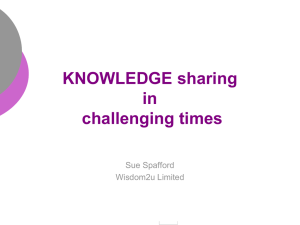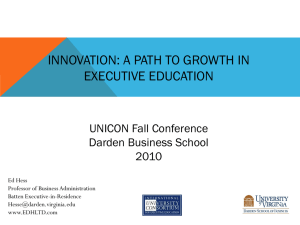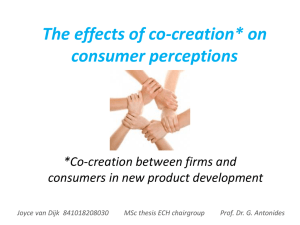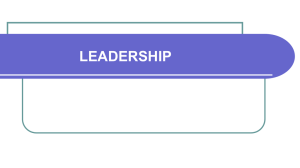Business Models of Co-creation - UC Berkeley School of Information
advertisement
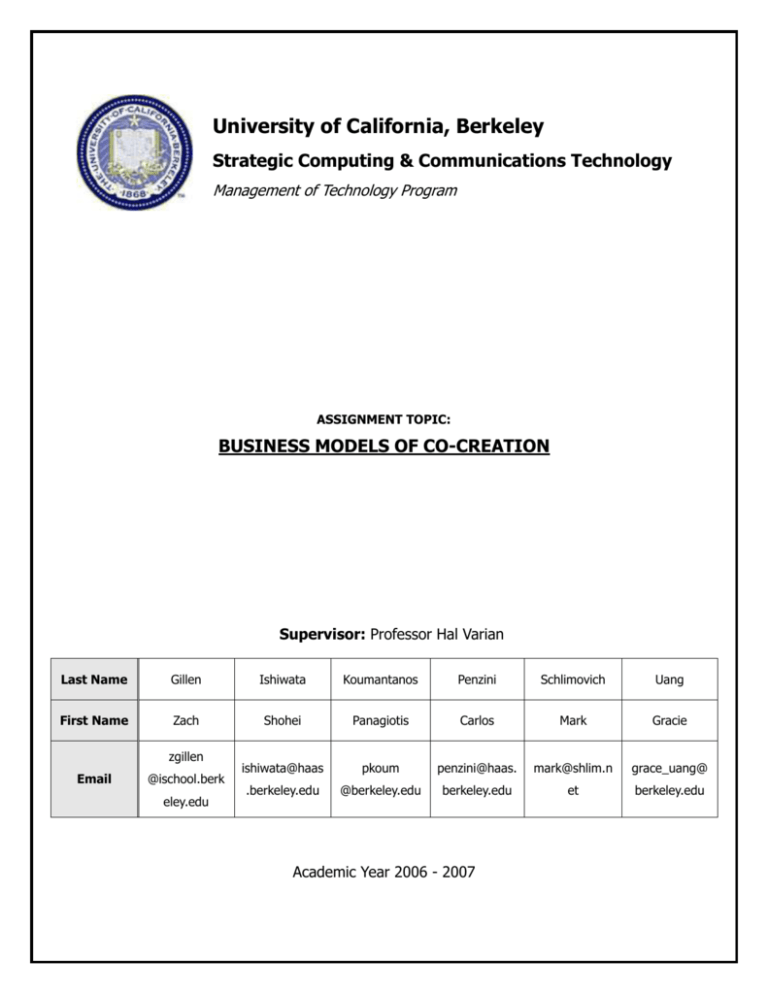
University of California, Berkeley Strategic Computing & Communications Technology Management of Technology Program ASSIGNMENT TOPIC: BUSINESS MODELS OF CO-CREATION Supervisor: Professor Hal Varian Last Name Gillen Ishiwata Koumantanos Penzini Schlimovich Uang First Name Zach Shohei Panagiotis Carlos Mark Gracie ishiwata@haas pkoum penzini@haas. mark@shlim.n grace_uang@ .berkeley.edu @berkeley.edu berkeley.edu et berkeley.edu zgillen Email @ischool.berk eley.edu Academic Year 2006 - 2007 Strategic Computing and Communications Technology Business Models of Co-creation TABLE OF CONTENTS 1. INTRODUCTION ................................................................................................................................ 3 2. CO-CREATION BUSINESS MODELS AND EXAMPLES ................................................................ 5 3. BUSINESS MODELS SECTION ......................................................................................................... 8 3.1. 3.1.1. Background ................................................................................................................................... 8 3.1.2. Business Model Parameters .......................................................................................................... 8 3.2. CRAIGSLIST ......................................................................................................................................... 10 3.2.1. Background ................................................................................................................................. 10 3.2.2. Business Model Parameters ........................................................................................................ 11 3.3. YAHOO! ANSWERS ............................................................................................................................... 12 3.3.1. Background ................................................................................................................................. 12 3.3.2. Business Model Parameters ........................................................................................................ 13 3.4. 4. INNOCENTIVE ........................................................................................................................................ 8 WIKIPEDIA ........................................................................................................................................... 14 3.4.1. Background ................................................................................................................................. 14 3.4.2. Business Model Parameters ........................................................................................................ 14 CHARACTERISTICS AND RISKS OF BUSINESS MODELS........................................................ 16 4.1. MOVEMENT WITHIN THE BUSINESS MODELS ...................................................................................... 16 4.2. RISKS ................................................................................................................................................... 17 4.3. CHALLENGES ....................................................................................................................................... 17 4.4. REMUNERATION .................................................................................................................................. 18 REFERENCES ........................................................................................................................................... 20 INDEX OF TABLES Table 1: Differences between Traditional Exchange and Co-Creation Experience................. 4 Table 2: Categorization of co-creation business models .............................................................. 7 UC Berkeley Page 2 of 21 Spring 2007 Strategic Computing and Communications Technology Business Models of Co-creation 1. Introduction Our market structure and society has been undergoing a major transformation since the beginning of the twenty-first century: there has been a “shift in power from businesses that determine what customers need and then manipulate demand to meet their offerings to networks of customers and producers who jointly create value.” According to Prahalad, “It's the democratization of industry…we are seeing the emergence of an economy of the people, by the people, for the people." Our industrial world is generating more goods and services than ever, delivered through an increasing number of channels, creating a complexity that confounds and frustrates most consumers. “Ubiquitous connectivity, globalization, industry deregulation, and technology convergence are blurring industry boundaries and product definitions,” is causing “worldwide flows of information, capital, products, and ideas, allowing nontraditional companies to upend the status quo.” Since competition is rising and profit margins are dwindling, managers cannot base their objectives on traditional concepts like costs, product and process quality, speed, and efficiency. In order to keep up with the new evolving age, managers must seek new sources of innovation and creativity (Prahalad, et al. 2004). In the conventional value creation process, companies and consumers had discrete roles of production and consumption. “Products and services contained value, and markets exchanged this value, from the producer to the consumer.” However, this distinction disappears in co-creation (see Table 1 for differences between traditional exchange and co-creation experiences). Co-creation “creates a new dynamic to the producer/customer relationship by engaging customers directly in the production or distribution of value” (Kambil 1999). Consumers are increasingly engaging in both defining and creating value—the co-creation experience of the consumer becomes the very basis of value. In other words, the “most basic change has been a shift in the role of the consumer-from isolated to connected, from unaware to informed, from passive to active.” The impact of this new-age consumer is evident in the areas of information access, global view, networking, experimentation, and activism (Prahalad, et al. 2004). User-created content is one form of co-creation. User-created content is when an end-user uses a service to mediate the creation and/or distribution of their creative work. While user-generated content refers to content (information, or some form of creative work), co-creation is broader in that it includes any kind of joint value creation between a firm and its customer. UC Berkeley Page 3 of 21 Spring 2007 Strategic Computing and Communications Technology Business Models of Co-creation Given the new active role of consumers, as well as the changing relationship between the consumer and the company, the locus for the co-creation of value lays in the emerging pattern of interactions between them. The key building blocks of co-creation are dialogue, access, risk assessment, and transparency. Dialogue encourages knowledge sharing, and more importantly, a shared level of understanding between customer and company. The goal of customers is access to desirable experiences—not necessarily the traditional focus on the ownership of the product. Risk assessment assumes “that if consumers become co-creators of value with companies, then they will demand more information about potential risks of goods and services; but they may also bear more responsibility for dealing with those risks.’ The fourth building block is transparency, where company information becomes more accessible to the consumer, which is necessary to create trust between the two parties. Table 1: Differences between Traditional Exchange and Co-Creation Experience (Prahalad 2004) There are countless examples of co-creation, including Lego, Linux, Skype, Wikipedia, and Ebay. LEGO Group uses the internet to identify and rally its most enthusiastic customers to help it design and market more effectively (Hof 2005). The Linux operating system is a co-created product. Because it is an open-source software, thousands of users and programmers have been able to enhance the features UC Berkeley Page 4 of 21 Spring 2007 Strategic Computing and Communications Technology Business Models of Co-creation of the operating system (Kambil 1999). Skype allows people to make better quality phone calls over the internet. When users start up Skype, they automatically lend their spare computing power and internet connection to the Skype network, which uses that collective resource to route other users’ calls. All Skype requires is the willingness of users to share (Hof 2005). Wikipedia is a free on-line encyclopedia with 1.5 million entries from volunteers experts around the world, in 15 languages, and 5 million people per month visit it (Hof 2005). E-bay provides the technical platform for a friendly user-interface for the forum in which people write their own listings, complete the exchange process on their own, and can rate each other based on their reliability as a seller. Each of these examples is similar and different in its own way. This paper looks at which product categories are good candidates for co-creation, then presents a model which represents the different product categories, where their common characteristics within each product category are then examined. Next, a business model is presented that companies could employ to motivate users to contribute to their products or business in a manner similar to co-creation. Different ways of offering contributors of cocreated items remuneration are explored. Finally, it is important to address the risks of co-creation, and how to prevent people from gaming the system. 2. Co-creation Business Models and Examples First, we examine the co-creation business models within a conventional framework. Business models are the way you earn revenue from customers and are defined by these principles: Target market, Value proposition, Position in Value chain and network, Revenue model and cost structure and Competitive strategy. Breaking the business model into the following components will allow us to analyze how co-creation will fit the model. Target Market - Any market can be a target. Some markets are a better fit for co-creation firms, such as markets with easily modifiable products. Many software manufacturers fall into this category, especially those that serve software as a service. Google and Salesforce are examples of companies that can rapidly develop and change software depending on customer requirements and satisfaction. Value proposition UC Berkeley Page 5 of 21 Spring 2007 Strategic Computing and Communications Technology - Business Models of Co-creation The value proposition involves the firm providing the co-creation experience to the consumer. Here, the customer connection, customer understanding or customer base can be a strong value proposition for co-creation firms. Position in Value chain and network - Co-creation firms can be anywhere in the value chain. This is especially true if the company has developed a distinct relationship with the customer. This issue must be indifferent from conventional firms. Revenue model and cost structure - This is the most significant factor for co-creation. Because several different participants literally co-create value at co-creation business models, it is not easy to calculate the portion of a contribution from each participant and to distribute value or revenue to each. This will be examined within the business models section of the paper. Competitive Strategy - Co-creation firms have tight relationships with customer groups through its co-creation experience. This relationship positively affects switching costs and lock-in of the customer. Also, co-creation business tends to have strong network effects. Co-creation is an emerging concept and doesn’t have a single dominate business model at present. As a result, there are many possible models could emerge in the future. It is helpful to categorize business models of co-creation and to view the differences between them. This is necessary to understand the various aspects of the value within co-creation and observe how firms migrate from one distinct category to the next over time. We classified the co-creation business model into four distinct categories: revenue of stake holders, the firm and the consumer. Within the first category, both the firm and users don’t earn revenue. The examples here are companies such as Wikipedia and Linux. For Wikipedia, the firm is operated as a non profit. Linux on the other hand is a loose user community of volunteers contributing to a final software product. In the second category, the firm earns a profit but user does not. The examples in this case are Lego Mindstorms and Yahoo Answers. Within this scenario, the firm may get revenue and profit from advertisers or derive value directly from the user. The customers in this category are also making voluntary contributions, often without monetary remuneration. The third category is that the company doesn’t earn profit but the users do. These companies may organize user groups under a non profit company structure, but these users take part in this model for economic incentives. The final category is where both the firm and user make a profit. Firm and user benefit economically through many ways of business. UC Berkeley Page 6 of 21 Spring 2007 Strategic Computing and Communications Technology Profit Business Models of Co-creation Yahoo Answers, Lego Mindstorm Firm gains revenue by providing platform from user, advertisement, etc User mainly enjoys benefits for free Innocentive, iTMS+iPod, Ebay Firm gains revenue by providing platform User economically benefited by playing on this platform Wikipedia, Linux, (Delicious) Craigslist Firm No Profit Everybody takes part voluntarily. Value incentive is often personal. No Profit User Firm acts like NPO and supports users to gain revenue. Profit Table 2: Categorization of co-creation business models UC Berkeley Page 7 of 21 Spring 2007 Strategic Computing and Communications Technology Business Models of Co-creation 3. Business Models Section 3.1. InnoCentive 3.1.1. Background InnoCentive was launched in June 2001 as the evolution of BountyChem, a spin-off from the pharmaceutical company Eli Lilly, and acted as an intermediary between companies (“seekers”) and researchers (“solvers”). The company’s first calendar quarter in 2002 was low, as was low again in 2003. That unevenness was hard to explain. In 2005, however, InnoCentive received an equity investment from a VC giving it both capital support for future growth, as well as a second strategic investor apart from Lilly. By September 2003 InnoCentive had 25,000 independent registered solvers, more than 7000 signed agreements and 750 submissions, and 25 awards paid out to solvers. By summer 2005, there were 80,000 solvers registered in its website from 173 countries. 3.1.2. Business Model Parameters Target Market The target market was the research and development (R&D) field of large pharmaceutical companies such as Eli Lilly, consumer product firms such as Procter & Gamble, and industrial chemical organizations such as Dow. Value Proposition The low productivity of R&D for those industries meant that costs were rising. Especially for the pharmaceutical industry between 1987 and 1993 its expenditures rose by 250%, while the number of submissions to the FDA dropped by 71%. The cost per approved drug increased for more than 800%, or 11% per year. On the other hand InnoCentive could offer a benefit to cost ratio of about 20:1 for R&D. At the other side of the market, solvers were given the opportunity to concentrate on problems relevant to their area of expertise. Key Features to Deliver Value InnoCentive provided a market for companies to post their research problems and tap into a large source of solvers for solutions. The solvers included contract laboratories, retirees, students, university UC Berkeley Page 8 of 21 Spring 2007 Strategic Computing and Communications Technology Business Models of Co-creation faculty, small pharmaceutical firms, biotech firms, research institutes, and other industries and scientific disciplines. Acting as an agent for a seeker company, InnoCentive entered into a legal agreement with them and then provided training to their R&D chemists so as to help them formulate their problem in a way that could be entered into the InnoCentive website. Defining success criteria and clear parameters for the problems whilst simultaneously protecting the company’s proprietary information proved to be a major challenge. After the problem was property defined and an award amount determined, an abstract would be posted on the website for public view. In the event that a person wanted to tackle that specific problem he would have to register with InnoCentive as a solver, providing contact and identification information, and sign a solver agreement. Then a private room would be created where the solver and InnoCentive’s staff would work together to refine the solution. Having fulfilled the company’s success criteria, the solution would be submitted to the seeker company. After the end of deadline set by the seeker, the best solution would be chosen by him. Finally, InnoCentive would verify the identity of the solver and provide a payment to him and would also send an invoice to the seeker including a success fee. The identities of the participants would be revealed on both sides only after a verified submission has been accepted and an award paid out. Value Chain and Outsourcing Crowd sourcing allows companies to tap the skills and knowledge of Internet users to carry out discrete tasks, generate valuable new ideas or solve specific business problems. InnoCentive acts as an intermediary in a crowd sourcing type model. It puts forward its reputation and credibility to attract seekers and solvers that might otherwise have been reluctant to cooperate due to IP and competition related issues. Revenue Mechanisms InnoCentive has built its revenue mechanisms around the seeker community: - There is a posting fee - There is an annual fee in order to get access to the company’s scientific staff for acquiring help on clearly defining and articulating the problem set There is a success commission when a solution is chosen. Building the Value Network/Ecosystem One of the hardest issues was managing and expanding the network of seekers and solvers. In that UC Berkeley Page 9 of 21 Spring 2007 Strategic Computing and Communications Technology Business Models of Co-creation respect the backing of Eli Lilly was imperative. Also efforts were undertaken by Ali Hussein to recruit leading academic centers in India, China, Russia etc. that could provide credibility and legitimacy to the company. From a marketing point, the company engaged in the following efforts in order to attract members from both communities: It sponsored relevant scientific events It was present at conferences in which solvers might attend It published some of its challenges in scientific publications. 3.2. Craigslist 3.2.1. Background In 1994 Craig Newmark was an employee at Charles Schwab, performing computer security tasks and looking for ways to improve his social life. In this effort he started an e-mail list amongst his friends about events and happenings in and around San Francisco. As word spread the list grew (in 1995 the list contained 250 names) and Craig decided to design a site through which he could inform people about upcoming art and technology events in the Bay Area. He also used this site as a modest place to post his resume. After starting Craigslist the founder left Schwab and started doing software contracting. This occupation let him have more free time to invest into the website. The growth of Craigslist was gradual because of two reasons: 1) Craig did not treat the site as a main occupation (it was only in December 1998 when he setup a real company), and 2) the site was neither promoted nor advertised. Its growth was obtained solely by word of mouth and its expansion was directed by user demand. During the dot-com boom, though, Craigslist was transformed into one-stop web site for all things in San Francisco, and especially apartments and jobs. In 2004 eBay purchased 25% of the stakes of Craigslist, spreading discontentment among its fanatic base due to the fact that Craigslist was perceived as being the anti-eBay solution in the Internet realm. Its informality, its spartan design, its persistence in not having advertisements, no cookies, no co-marketing agreements, and no selling of user information to third parties were those characteristics that differentiated it from eBay as well as from its other competitors. Even if the stake transfer was not in the plans of the company, Jim Buckmaster (Craigslist CEO) saw two potential opportunities in having eBay as a minority stakeholder: increasing consumer protection and accelerating the company’s globalization plans. Finally, as of 2005 Craigslist has been transformed from a simple e-mail list in 1994 into an UC Berkeley Page 10 of 21 Spring 2007 Strategic Computing and Communications Technology Business Models of Co-creation international portal through which people in 76 cities and 12 countries can search locally for jobs, dates, furniture and other products and services, doubling in size every year, as measured by page views and listings. The site has 5 million unique visitors every month and in July 2004 it crossed the 1 billion monthly pageview mark for the first time indicating a fanatical user base like Amazon, eBay, Google and Yahoo!. It is the 47th most visited site and ranks 9th in the number of pageviews. 3.2.2. Business Model Parameters Target Market Craigslist does not seem to have a specific target market, but instead uses different pools/categories to attract a wide variety of users. Value Proposition Craigslist’s value proposition lies in that it concentrates on providing a public service as opposed to maximizing profits. The philanthropic philosophy that has been adopted seems appealing to a wide user base. When “serving customers come first and worrying about revenues comes second” a lot of buyers and sellers are drawn to the site causing positive feedback loops (more sellers attract bore buyers and vice versa). On the other hand, due to its public service attitude both the founder and CEO are not interested in materializing the value of their service and seem content with acquiring modest profits. Key Features to Deliver Value The implementation of the company’s vision and commitment to public service can be approached from two angles: the angle of the people posting ads, and the angle of the people responding to them. From the perspective of the people posting ads the fee is smaller relative to other media or even free and moreover they achieve high user/customer attention rates. Actually Craigslist has cost the San Francisco Bay Area newspapers up to $65 million in unemployment advertising revenue (report of 2004) and millions more in merchandise and real-estate advertising. At the other side of the equation, the buyers (or the people interested in the ads) see Craigslist as a trustworthy one-stop shop point for a lot of their needs. Knowing that their private information is protected and enjoying little annoyance from ad banners and pop-ups their experience is enhanced and a community atmosphere is created. Given that in our modern society the community feeling is lacking it could be stated that the Craigslist helps people fulfill their “belongingness needs” – Maslow’s third hierarchical level of needs. UC Berkeley Page 11 of 21 Spring 2007 Strategic Computing and Communications Technology Business Models of Co-creation Value Chain and Outsourcing The value chain consists of three components: the buyers, the sellers, and Craigslist. Craigslist adds value to the service in the following ways: allows moderation and flagging of irrelevant or scam posts, it provides a sense of community since even “Craig” is an actual person with which you can directly communicate, and it allows the participation in a non-commercial trading experience where the users don’t feel as dollar targets for the intermediary. Revenue Mechanisms The revenue mechanism of the company encompasses the postings on jobs and apartments. For the San Francisco Bay Area each job posting costs $75, whereas the job postings for New York and Los Angeles cost $25. In addition Craigslist charges $10 per apartment posting for New York. For all other cities the postings are free. Building the Value Network/Ecosystem As mentioned in the “Background” section Craigslist is not making any active efforts to expand its user base through advertising or promotions. It relies on word of mouth and indirect advertising (i.e. interviews etc.). A new feature that is being considered for adding values is citizen journalism. 3.3. Yahoo! Answers 3.3.1. Background The dynamic of question-answering is different than other user created content. In Amazon, TripAdvisor or Citysearch people would play the role of “critic”. In del.icio.us and Flickr, even if the tagged items are made public, the initial motive was borne at least somewhat from self-interest; the organization of bookmarks and photos. In question-answering, though, a true Samaritan is needed for spending time into answering questions and an even better Samaritan to repeatedly and without compensation continue to do so. Ego does not play a great part as a motive because the answers are fairly quickly lost in the system. Yahoo! Answers was launched in 2005 as a response to Google Answers, which was launched in 2002. The two services implemented two different models. At the time when Google Answers was launched cheap user generated content wasn’t valued much, the advertising market was in a slump, and it was extremely hard to monetize pageviews when compared to today’s situation. For that reason Google UC Berkeley Page 12 of 21 Spring 2007 Strategic Computing and Communications Technology Business Models of Co-creation decided to embrace a model of getting direct revenue. A user would post a question and an expert from a pool of over 500 pre-qualified researchers would answer it. The user posting the question would pay a fee to the expert in the range of $2 to $200 and Google would get a 25% share. Over the 4 years Google Answers operated only 800 people participated. Conversely, Yahoo! Answers tried a different approach that is analyzed in the following section. In 2006 Google decided to terminate its Answers, thus granting Yahoo! the victory to a long war. It is estimated that 2% of all U.S. Internet users have visited the service at least once. By August 2006 people had written over 30 million answers to questions and it had become one of Yahoo’s bigger properties. Over 60 million unique worldwide monthly visitors have written 160 million answers. 3.3.2. Business Model Parameters Target Market Yahoo! Answers does not target any particular community or market segment. The questions posted can relate to any category and involve specialized or non-specialized knowledge. That being said, it is probable that users who require answers on specialized topics within a short time period are not served as efficiently due to the lack of qualified respondents. Value Proposition The value proposition of Yahoo! Answers is that users can tap into the knowledge of the community instead of searching endlessly in the Internet for facts and sources. In addition the members can share experiences and information on various topics, products and services. Key Features to Deliver Value According to the business model users can post questions and answers for free. To achieve motivation recognition is enhanced through a reputation management point system. Users get points every time they answer a question, according to the community rating of their response, and lose points when asking questions. Points elevate their stature in the system, lending their posts credibility, and different leaderboards propel feelings of accomplishment. To some degree, points give more access to the service. Rookies, for example, can’t post many answers and questions; they are restricted. Value Chain and Outsourcing The value in Yahoo! Answers is solely created by the users. Yahoo! gets some of the value through UC Berkeley Page 13 of 21 Spring 2007 Strategic Computing and Communications Technology Business Models of Co-creation advertisements and the opportunity of using the content for other applications. Revenue Mechanisms The revenue mechanism for Yahoo! Answers is related to the service’s search option. When using the search option there is pay-per-click advertising specialized to the category and keywords used. Otherwise the actual site does not contain any advertisements and the business model does not contain any other revenue stream mechanisms. Yahoo!, as part of the complementary model is considering aggregating Yahoo! Answers, del.icio.us, Flickr and more into fan sites. This would create a “brand universe” that would attract targeted advertising. Building the Value Network/Ecosystem Yahoo! tries to build the network by channeling people to Yahoo! Answers through its search engine and other services. As the network grows its value grows exponentially through positive feedback and further growth is achieved through word of mouth. 3.4. Wikipedia 3.4.1. Background Wikipedia is probably the single largest effort of digital information co-creation in existence. The concept is simple; provide an electronic platform on which people can contribute knowledge in the form of an encyclopedia. This new model has devastated long time players Encyclopedia Britannica and World Book. Suddenly, with cheap computing power, digital storage and broadband access, the ability to host and retrieve a large quantity of information at low cost was possible. The early business model focused on generating revenue by advertising within the Wikipedia pages. This failed due to concerns of user migration to other platforms not employing advertising. Wikipedia is currently a non-profit organization that receives charitable donations for maintaining basic hardware, rental etc. 3.4.2. Business Model Parameters Target Market Wikipedia does not have a targeted community, except that they’re looking for everyone who can add valuable information to the encyclopedia. The further the reach of Wikipedia, the more valuable UC Berkeley Page 14 of 21 Spring 2007 Strategic Computing and Communications Technology Business Models of Co-creation contributions will be made to the site. The difficulty can sometimes be getting users to contribute that are holders of valuable information. Value Proposition The value proposition of Wikipedia is that they’re providing an open-source methodology for information cataloging in the form of an encyclopedia. In this model, the user can contribute or edit the content and continue adding value to the product. The larger the audience and contributors, the more value is added to Wikipedia. This is providing a single, free repository of information. Key Features to Deliver Value The users can view, edit or delete all entries into the online encyclopedia. The incentive is mainly based on people’s willingness to contribute their knowledge and interests in the world around them. Wikipedia has also established a user community and the ability to associate the contributions made within the site. This adds to the credibility of the user and establishes elevated reputation within the community as a contributor. The encyclopedia currently has over six million articles in two hundred and fifty languages. Value Chain and Outsourcing The value in Wikipedia is solely created by the users who contribute to the encyclopedia by adding sections, or editing pages. There is a core community of users that maintain the overall integrity and monitor attacks. Revenue Mechanisms This is the most interesting component of Wikipedia. In late 2002, almost three years after Wikipedia was founded, Jimmy Wales announced the removal of advertising from the site and the transition of the company to a non-profit. This move came after a Spanish version called ‘Enciclopedia Libre’ forked from Wikipedia citing fears of commercial advertising and lack of control. The Wikipedia group realized the low lock-in surrounding an idea based on free information and became nervous of continued ‘forking’ of sites and new competitors gaining traction in the market by including advertisements. As a result, Wikipedia switched to a non-profit model. The advantage of Wikipedia is the current dominance in the market over other entry Wiki efforts. The precarious nature of the position is reflected by the resistance of the organization to adopt a ‘For Profit’ model. With over two and a half billion page views a month, the ability to generate revenue seems inherent. However, the cost of low lock-in reduces the ability of Wikipedia to seek profit. This is UC Berkeley Page 15 of 21 Spring 2007 Strategic Computing and Communications Technology Business Models of Co-creation especially relevant given the un-biased structure of the organization’s goals of providing quality information. Building the Value Network/Ecosystem The Wikimedia organization was created in June 2003 to consolidate the various Wiki ventures within the company. These efforts are intended to provide a free, global encyclopedia to the world. 4. Characteristics and Risks of Business Models 4.1. Movement within the Business Models Under the four-square business model above, movement will depend on company goals, the type of desired co-creation and maturity of the firm. Drawing specifically from the business model examples from above, this section will examine the movement of companies in the process of developing profitable co-creation. In the case of InnoCentive, the company was developed with a clear business model that combined seekers with solvers of specific problem. The solution provides revenue for the companies who are essentially outsourcing specific problems, while the best solvers are compensated for their effort. InnoCentive provides a value platform, which is similar to eBay in that it combines sellers and purchasers. The difference is providing this platform for services as opposed to physical goods. The other three categories involve at least one entity not receiving monetary compensation. Initial co-creation ventures will often begin without a clear business plan for gaining revenue and market traction. A good example in this category is del.icio.us. This company provides social tagging mechanisms to create value by horizontal search across the similar tags. Until del.icio.us was acquired by Yahoo in December of 2005, they were not profitable. While Yahoo does not directly earn money directly from del.icio.us, there is speculation that Yahoo is studying tag distributions to refine their search and categorization mechanisms. The value created for the user are bookmarks independent of a physical device and the ability to search on similar tags within the network to discover sites of interest. The other interesting example of business model movement is Wikipedia opting for a non-profit status. At the time, the low maturity of information was spawning alternative Wiki sites and there was UC Berkeley Page 16 of 21 Spring 2007 Strategic Computing and Communications Technology Business Models of Co-creation fear that advertisements would affect the content quality. The result influenced Wikipedia to switch to a non-profit business. Today, there is enough information and brand maturity that advertising would generate millions in revenue. Subscription fees and incorporating ancillary businesses for book sales have been suggested as revenue structures under this model. However there is resistance from the user communities who are attracted to the low-cost of buy in, then have subscription fees added once critical mass is achieved. An interesting result is the creation of Wikia, a company founded by Jimmy Wales of Wikipedia. This company is creating user-group Wiki communities for commonly discussed topics, such as ‘Star Trek’ and the television show ‘Lost’. Employing advertising as a revenue generator, they intend to provide a platform that’s open to both praise and criticism. The primary advantage is that the content is not owned by the Production Company, or television studio. Providing this type of forum allows open discussion without information censorship. 4.2. Risks There are three major considerations surrounding risk. The first deals with concerns regarding end-users and their privacy. Firms should never sell or share information without the explicit consent of owners. The second involves the legalities of content submission infringing on any copyrights, intellectual property rights, or libel laws through the submission of unverified content. As the distribution channel of this information, you may be responsible for laws that it violates. Finally, brand equity can be diminished as quickly as customers who are co-creating value can build it. Content that is being cocreated needs to be monitored for quality and for alignment with the messages the parent company wishes to send its customers and the position that it wants to create for itself. One way to self-regulate quality is to make user-ratings or reputation systems an integral part of the process. 4.3. Challenges The first main challenge is goal divergence between the firm and the user. Clearly co-creation for its own sake is not a wise strategy. Successful co-creation must advance the missions of both the customer and the merchant involved and shared goals must be aligned. It is important to turn to cocreation only when shared value can be created and objectives are shared. For example, customers are looking to cut costs, while suppliers are looking to maximize profits. Incentives must be aligned so that all parties involved can further their ends, while furthering the ends of the other party. In addition to understanding incentives, a careful cost-benefit analysis should be applied to determine whether the UC Berkeley Page 17 of 21 Spring 2007 Strategic Computing and Communications Technology Business Models of Co-creation downsides of co-creation are outweighed by the opportunity. It is important that the relationship does not create scenarios that result in zero-sum games between the parties involved. For example, the cost vs. profit situation mentioned above is one such example where the goals and incentives of one of the parties are positioned directly against the other. Co-creation should be used only when a win-win relationship can be realized. Often times laying the initial groundwork to setup a relationship for co-creation is not easy and requires an upfront investment. In the case of Wikipedia, content must first be created before value is introduced to the system. For example, when the customer is creating content, it may be necessary to make available or procure the necessary tools for constructing content and a good usability story may be necessary in order to maximize the value of the relationship. By investing in creating good infrastructure, systems providers can create a valuable ecosystem for the customers that they govern. Ebay has succeeded in creating a lucrative ecosystem where they simply provide infrastructure for the customers who interact with one another. The systems infrastructure is the basis of any online community. By reducing the effort that customers invest into co-creation by making their website useful and easy to and use will attract the necessary following to achieve the desired value. 4.4. Remuneration Contributors must perceive equitable rewards for their efforts. It is important that the returns they receive from their contributions give them incentive to contribute. Even status within the online community can often be an incentive for users to contribute. Other forms of compensation include monetary compensation, chance to win prizes, or free product promotion opportunities. One issue with remuneration is providing the appropriate filters and processing to prevent users from manipulating the process. Evaluation the quality of the contribution is critical and could even be evaluated by the user community. A possible example could be related to Wikipedia. The contributing communities could evaluate the quality of the various contributions and create a ranking system. Having a larger community evaluate the contributions removes the work from the company. Again, the problem here becomes the ability of the user community to contribute fairly and maintain the overall quality. It should be clearly identified what portion of the value chain customers affect. For each such part of the value chain, objective metrics should be established in order to identify the value of contributions. Another important element is limiting the contribution access. This can increase the quality and sophistication level of contributions. It is important to identify whether a firms customers UC Berkeley Page 18 of 21 Spring 2007 Strategic Computing and Communications Technology Business Models of Co-creation even have the right skills in order to contribute to given areas of the value chain. By being selective about the customers that you invite to co-create, you can increase the quality of the final product. When customers provide information to producers, they trust that their information will not be misused. This helps to clarify the rights and acceptable uses of the information being produced. It is important to define the intended and acceptable uses of the work exchanged in the relationship. Finally, by controlling the channels through which co-created content is delivered to consumers and managing the relationships with consumers, producers can establish a position that is secure and sustainable. Customer relationships a network of producers and consumers are the most valuable assets that companies like eBay, Facebook, and Frost & Sullivan have. UC Berkeley Page 19 of 21 Spring 2007 Strategic Computing and Communications Technology Business Models of Co-creation References 1. Prahalad, C.K., and Venkat Ramaswamy. “The Future of Competition: Co-Creating Unique Value with Customers.” Boston, MA: Harvard Business School Press, 2004. 2. Hof, Robert D. “The Power Of Us: Mass Collaberation on the Internet is Shaking Up Business.” BusinessWeek online. June 20th, 2005. 3. Kambil, Ajitb, Friesen, G. Bruce, and Arul Sundaram. “Co-Creation: A New Source of Value.” Outlook 2 (1999): 38-43 4. Hempel, Jessi. “A Talk with Craiglist’s Keeper.” BusinessWeek, Sept. 8, 2004 5. Shapiro, Carl., and Varian, Hal. “Information Rules.” Harvard Business School Press. 1999. 6. Sorkin, Andrew Ross. “Craiglist Meets the Capitalists.” http://dealbook.blogs.nytimes.com/2006/12/08/craigslist -meets-the-capitalists/, January 28, 2005 7. Gray, Tim. “Craig Newmark, Founder, Craigslist.” http://www.internetnews.com/ec- news/article.php/3465/621, January 28, 2005 8. “Craigslist. On the Record: Craig Newmark.” http://www.sfgate.com/cgi- bin/article.cgi?f=/c/a/2004/08/15/NEWMARK.TMP, August 15, 2004 9. Hellweg, Eric. “Is Craigslist a Google 2.0?” http://money.cnn.com/2004/08/05/technology/techinvestor/hellweg/index/htm, August 5, 2004 10. Watchon, Frank. “Craigslist: Not Your Average Business Model.” http://blog.searchenginewatch.com/blog/061216-142816, December 16, 2006 11. Musil, Steven. “Report: Craigslist Costing Newspapers Millions.” http://news.com.com/Report+Craigslist+costing+newspapers+millions/2100-1024_3-5505076.htm 12. Simpson, Richard. “Yahoo! Looks at Adding Visual Element to Answers Service.” Nma.co.uk, September 7, 2006 13. Nelson, Paul (2006). “Yahoo Turns to People.” Travel Weekly: The Choice of Travel Professionals, issue 1824, p.4 14. Arrington, Michael. “Yahoo’s Big Win.” http://www.tchcrunch.com/2006/11/30/yahoos-big-win/, November 30, 2006. 15. Price, Gary. “Web Search History: Before Google Answers and Yahoo Answers there was AnswerPoint from Ask Jeeves.” http://blog.searchenginewatch.com/blog/051210-180902, December 10, 2005. 16. Schonfeld, Erick. “How Many Products Can Yahoo Launch a Week?” http://blogs.business2.com/business2blog/2005/12/how_many_produc.html, December 8, 2005. UC Berkeley Page 20 of 21 Spring 2007 Strategic Computing and Communications Technology Business Models of Co-creation 17. Cashmore, Pete. “Yahoo to Launch Brand Sites with Avatars, Yahoo Answers, del.icio.us, Flickr and More.” http://mashable.com/2006/11/30/yahoo-to-launch-brand-sites-with-avatars-yahooanswers- delicious-flickr-and-more/, November 30, 2006. 18. Arrington, Michael. “Yahoo Answers Launches.” http://www.techcrunch.com/2005/12/08/yahooanswers-launches, December 8, 2005. 19. Bazeley, Michael. “Yahoo Answers.” http://www.siliconbeat.com/entries/2005/12/07/yahoo_answers.html, December 7, 2005. 20. Chesbrough, Henry (2006). Open Business Models. Harvard Business School Press. 21. Rigby, Rhymer. “The Billion-Man Research Team.” http://www.ft.com/cms/s/b891b804-9ff9-11db9059-0000779e2340, December 14, 2006 22. Raynor, E. Michael, and Panetta, A. Jill, (2005). “A Better Way to R&D?” http://www.innocentive.com/about/media/20050329_HBS_BetterR&D.pdf 23. McNichol, Tom. “Wikipedia Founder Hunts for Gold.” Business 2.0 Magazine. February 27th, 2007. http://money.cnn.com/magazines/business2/business2_archive/2007/03/01/8401010/index.htm?postv ersion=2007022710 UC Berkeley Page 21 of 21 Spring 2007

